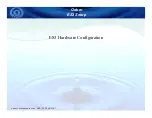
HDO6000 High Definition Oscilloscope
Sparser Function
The Sparse math function allows you to thin out an incoming waveform by skipping points at regular
intervals, and by starting acquisition at a particular offset (point). The
Sparsing factor
specifies the
number of sample points to reduce the input waveform by. A sparsing factor of 4, for example, tells the
oscilloscope to retain only one out of every 4 samples. A
Sparsing offset
of 3, on the other hand, tells the
oscilloscope to begin on the third sample, then skip the number of samples specified by the sparsing
factor (4). In this way, the sample rate is effectively reduced.
For the sparsing factor (interval), you can set a value from 1 to 1,000,000 points. For the sparsing offset
you can set a value from 0 to 999,999.
NOTE
: The maximum sparsing offset that can be entered for any sparsing factor equals Sparsing Factor 1.
1. Follow the usual steps to
set up a math function
, selecting
Sparse
from the
Misc
submenu.
2. Touch the
Sparsing factor
control and provide a Bandwidth Limit value.
3. Touch the
Sparsing offset
control and provide a value.
Rescaling and Assigning Units
This feature allows you to apply a multiplication factor (
a
) and additive constant (
b
) to your waveform:
a
X
+
b
. You can do it in the unit of your choice, depending on the type of application.
Set Up Rescaling
1. Follow the usual steps to
set up a math function
, selecting
Rescale
from the
Functions
submenu.
2. Touch the
Rescale
right-hand dialog tab.
3. To apply a multiplication factor:
l
Check the
First multiply by:
box and enter a value for
a
, the multiplication factor.
l
Touch
then add:
and enter a value for
b
, the additive constant.
4. To change the output unit of measure from that of the source waveform:
l
Check
Override units
.
l
In
Output
enter the abbreviation for the unit the measure you wish to use.
You can also enter combinations of the unit abbreviations following these rules:
l
For the quotient of two units, use the character "
:/
"
l
For the product of two units, use the character "
.
"
l
For exponents, append the digit to the unit without a space: S2 = seconds squared.
NOTE
: Some units may be converted to simple units (e.g., V.A will display as W).
74
922499 Rev B
















































